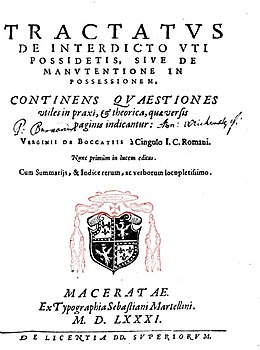保持占有
外观

保持占有(拉丁语:uti possidetis),亦称占领地保有,是国际法中的一项原则,主张除非条约另行规定,否则交战国在战争结束后可以保有其在战争期间借由武力所占有的领土和财产。[1]
与保持占有相对的国际法原则为战前状态(拉丁语:status quo ante bellum),主张交战各方恢复到战争发生前的势力状态。战争结束时,敌对双方签订的条约可以采纳保持占有原则,或战前状态原则,或两者之组合。如果条约对于借由武力所占领的领土和财产之归属没有特别规定,则以保持占有原则优先。[1]
保持占有原则是古典国际法承认的领土移转方式,但晚近则不再承认其为取得领土的合法方式,或对其取得领土的法律效力有所争论[2]。随着《联合国宪章》于1945年问世,借由武力取得领土违反《联合国宪章》,因此保持占有原则已不再是取得武力征服之领土的可行方式[3][4]。
注释
[编辑]- ^ 1.0 1.1 Uti possidetis Law & Legal Definition. USLegal, Inc. (uslegal.com). [16 August 2010]. (原始内容存档于2017-08-19).
- ^ 李明峻. 從國際法角度看琉球群島主權歸屬 (PDF). 台湾国际研究季刊. 2005年6月, 1 (2): 59 [2016-06-20]. (原始内容存档 (PDF)于2017-01-06).
- ^ Fozia Lone. Uti Possidetis Iuris. Oxford Bibliographies. March 23, 2012 [June 20, 2016]. doi:10.1093/obo/9780199796953-0065. (原始内容存档于2020-11-21) (英语).
However, with the adoption of the UN Charter in 1945, uti possidetis no longer served as a justified principle to seal title to territory acquired by conquest.
- ^ Giuseppe Nesi. Uti possidetis Doctrine
 . Oxford Public International Law. January 2011 [June 20, 2016]. (原始内容存档于2020-10-30) (英语).
. Oxford Public International Law. January 2011 [June 20, 2016]. (原始内容存档于2020-10-30) (英语). This notion of uti possidetis is no longer viable since the well-established principles on the use of force do not allow for any acquisition of territory that is in violation of the United Nations Charter.
参考文献
[编辑]- Sebastian Anstis and Mark Zacher (June 2010). "The Normative Bases of the Global Territorial Order." Diplomacy and Statecraft 21: 306–323.
- Helen Ghebrewebet: "Identifying Units of Statehood and Determining International Boundaries: A Revised Look at the Doctrine of Uti Possidetis and the Principle of Self-Determination", Verlag Peter Lang 2006, ISBN 3-631-55092-8.
参见
[编辑]外部链接
[编辑]- Lecture (页面存档备份,存于互联网档案馆) by Marcelo Kohen (页面存档备份,存于互联网档案馆) entitled "Uti Possidetis and Maritime Delimitations" in the Lecture Series of the United Nations Audiovisual Library of International Law (页面存档备份,存于互联网档案馆)
